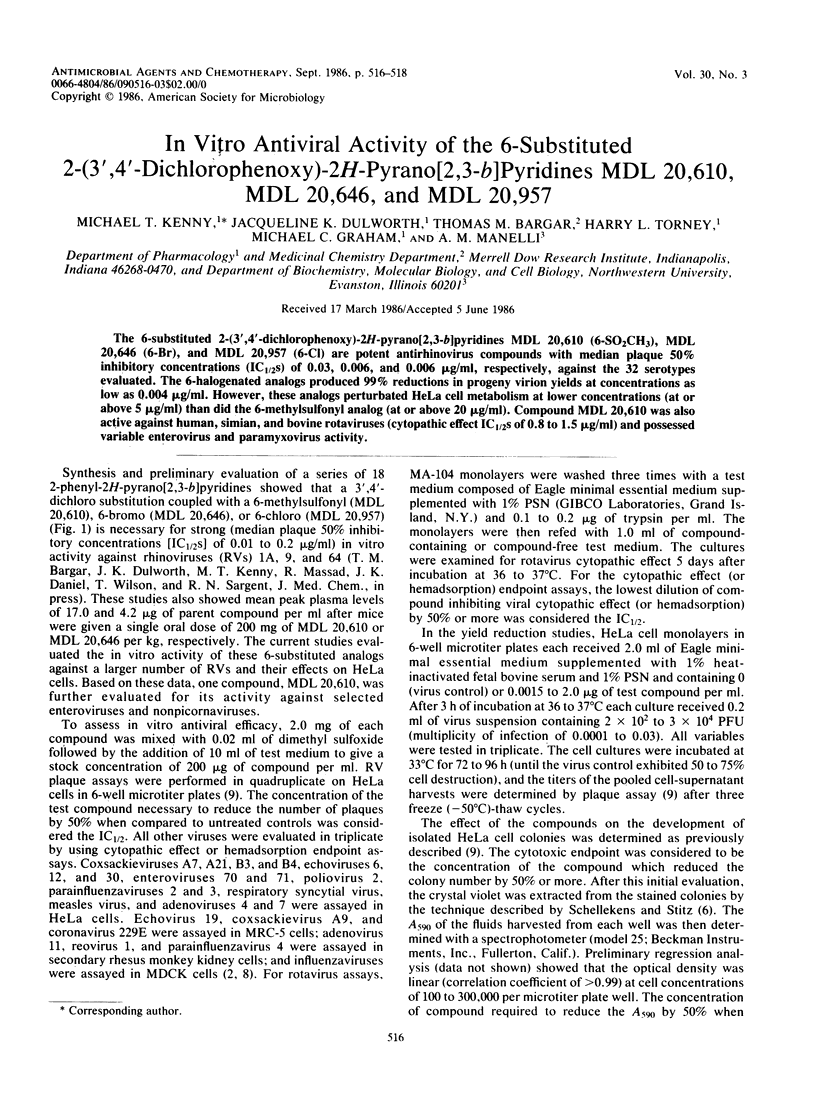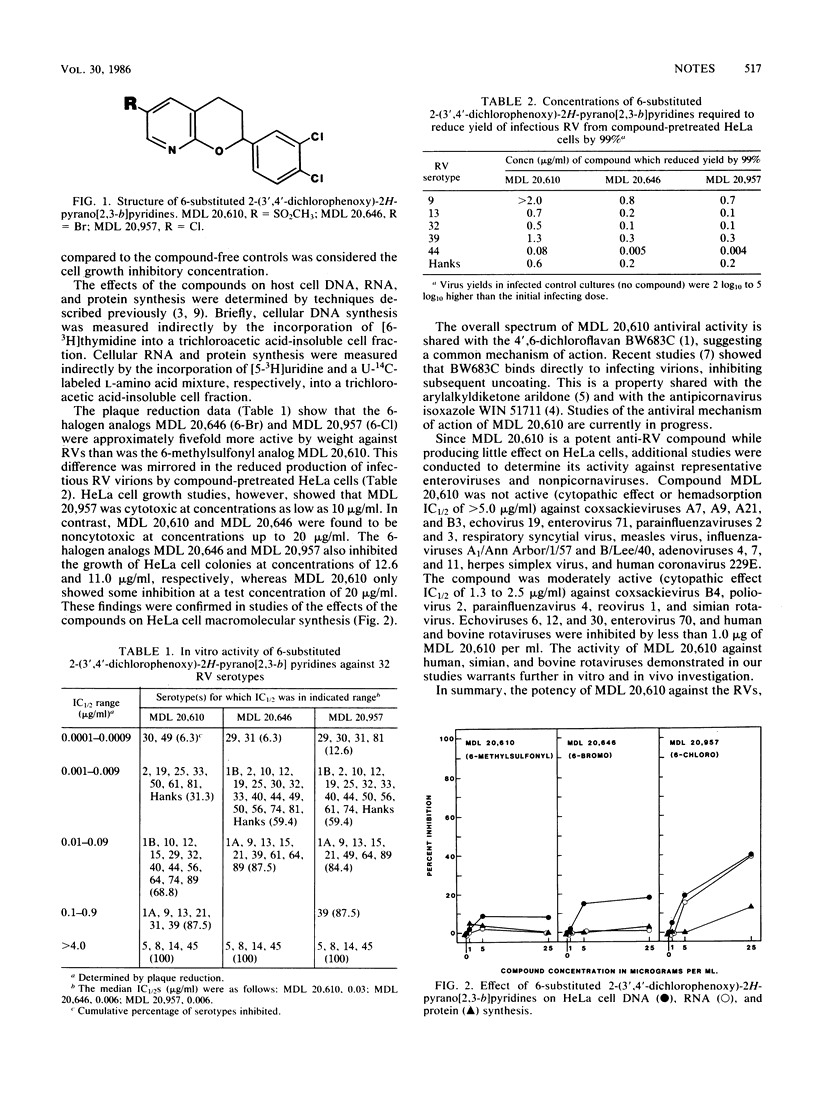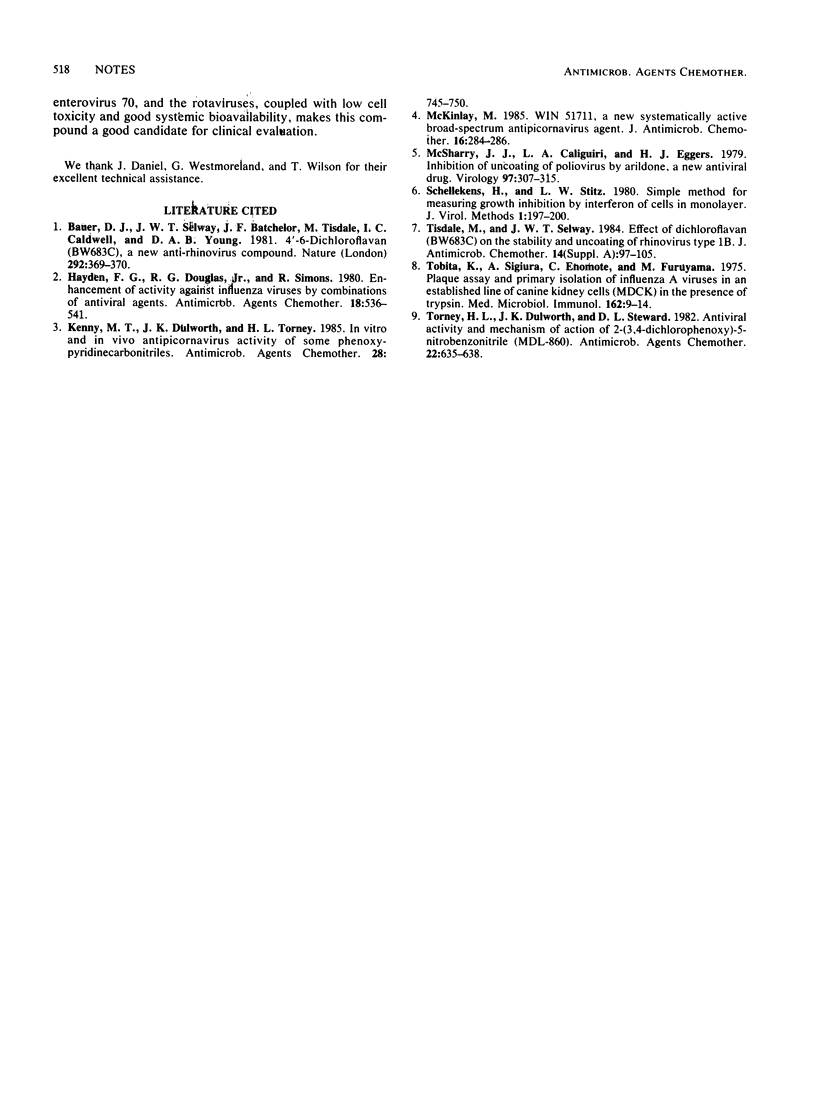Abstract
The 6-substituted 2-(3',4'-dichlorophenoxy)-2H-pyrano[2,3-b]pyridines MDL 20,610 (6-SO2CH3), MDL 20,646 (6-Br), and MDL 20,957 (6-Cl) are potent antirhinovirus compounds with median plaque 50% inhibitory concentrations (IC1/2s) of 0.03, 0.006, and 0.006 micrograms/ml, respectively, against the 32 serotypes evaluated. The 6-halogenated analogs produced 99% reductions in progeny virion yields at concentrations as low as 0.004 micrograms/ml. However, these analogs perturbated HeLa cell metabolism at lower concentrations (at or above 5 micrograms/ml) than did the 6-methylsulfonyl analog (at or above 20 micrograms/ml). Compound MDL 20,610 was also active against human, simian, and bovine rotaviruses (cytopathic effect IC1/2s of 0.8 to 1.5 micrograms/ml) and possessed variable enterovirus and paramyxovirus activity.
Full text
PDF


Selected References
These references are in PubMed. This may not be the complete list of references from this article.
- Bauer D. J., Selway J. W., Batchelor J. F., Tisdale M., Caldwell I. C., Young D. A. 4',6-Dichloroflavan (BW683C), a new anti-rhinovirus compound. Nature. 1981 Jul 23;292(5821):369–370. doi: 10.1038/292369a0. [DOI] [PMC free article] [PubMed] [Google Scholar]
- Hayden F. G., Douglas R. G., Jr, Simons R. Enhancement of activity against influenza viruses by combinations of antiviral agents. Antimicrob Agents Chemother. 1980 Oct;18(4):536–541. doi: 10.1128/aac.18.4.536. [DOI] [PMC free article] [PubMed] [Google Scholar]
- Kenny M. T., Dulworth J. K., Torney H. L. In vitro and in vivo antipicornavirus activity of some phenoxypyridinecarbonitriles. Antimicrob Agents Chemother. 1985 Dec;28(6):745–750. doi: 10.1128/aac.28.6.745. [DOI] [PMC free article] [PubMed] [Google Scholar]
- McKinlay M. A. WIN 51711, a new systematically active broad-spectrum antipicornavirus agent. J Antimicrob Chemother. 1985 Sep;16(3):284–286. doi: 10.1093/jac/16.3.284. [DOI] [PubMed] [Google Scholar]
- McSharry J. J., Caliguiri L. A., Eggers H. J. Inhibition of uncoating of poliovirus by arildone, a new antiviral drug. Virology. 1979 Sep;97(2):307–315. doi: 10.1016/0042-6822(79)90342-8. [DOI] [PubMed] [Google Scholar]
- Schellekens H., Stitz L. W. Simple method for measuring growth inhibition by interferon of cells in monolayer. J Virol Methods. 1980;1(4):197–200. doi: 10.1016/0166-0934(80)90058-0. [DOI] [PubMed] [Google Scholar]
- Tisdale M., Selway J. W. Effect of dichloroflavan (BW683C) on the stability and uncoating of rhinovirus type 1B. J Antimicrob Chemother. 1984 Aug;14 (Suppl A):97–105. doi: 10.1093/jac/14.suppl_a.97. [DOI] [PubMed] [Google Scholar]
- Tobita K., Sugiura A., Enomote C., Furuyama M. Plaque assay and primary isolation of influenza A viruses in an established line of canine kidney cells (MDCK) in the presence of trypsin. Med Microbiol Immunol. 1975 Dec 30;162(1):9–14. doi: 10.1007/BF02123572. [DOI] [PubMed] [Google Scholar]
- Torney H. L., Dulworth J. K., Steward D. L. Antiviral activity and mechanism of action of 2-(3,4-dichlorophenoxy)-5-nitrobenzonitrile (MDL-860). Antimicrob Agents Chemother. 1982 Oct;22(4):635–638. doi: 10.1128/aac.22.4.635. [DOI] [PMC free article] [PubMed] [Google Scholar]


